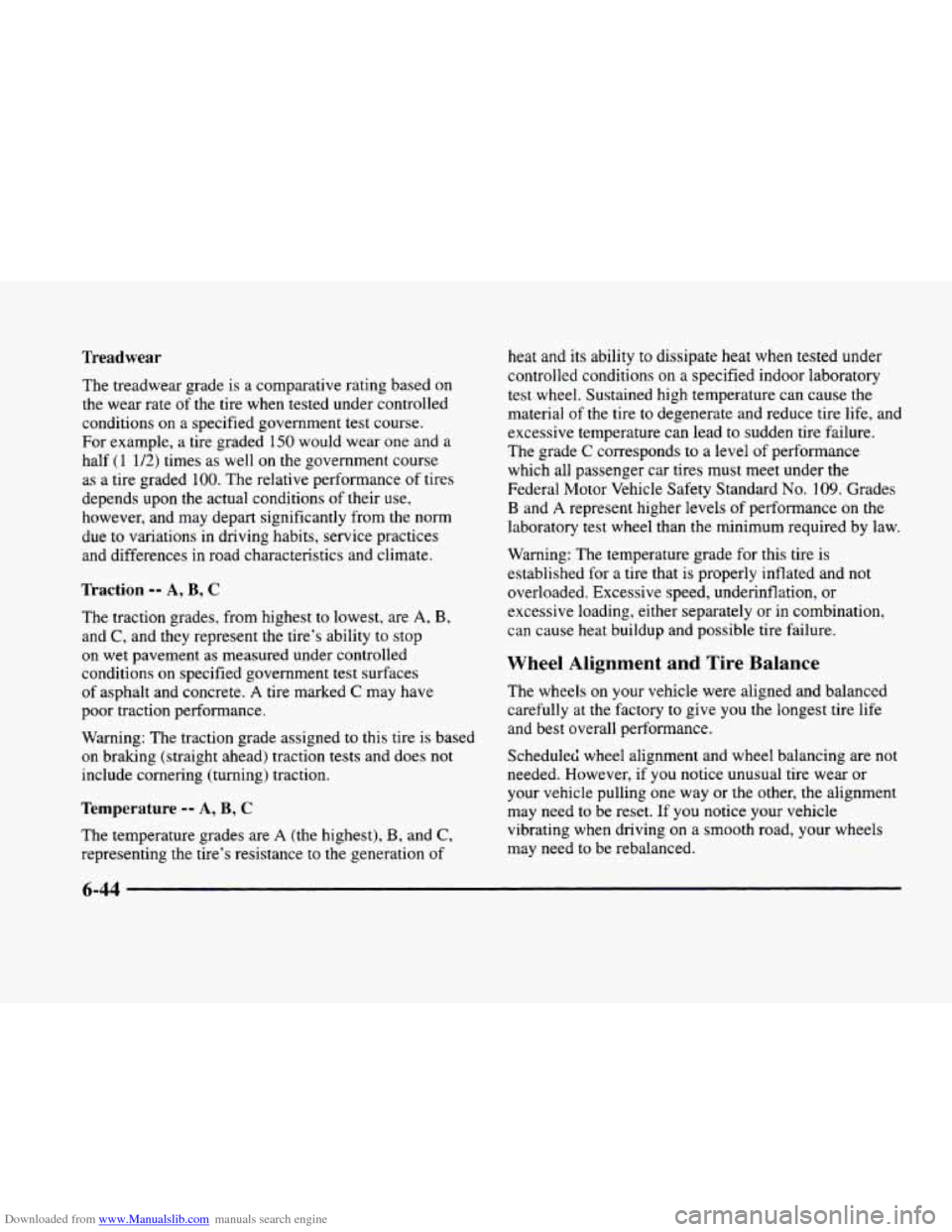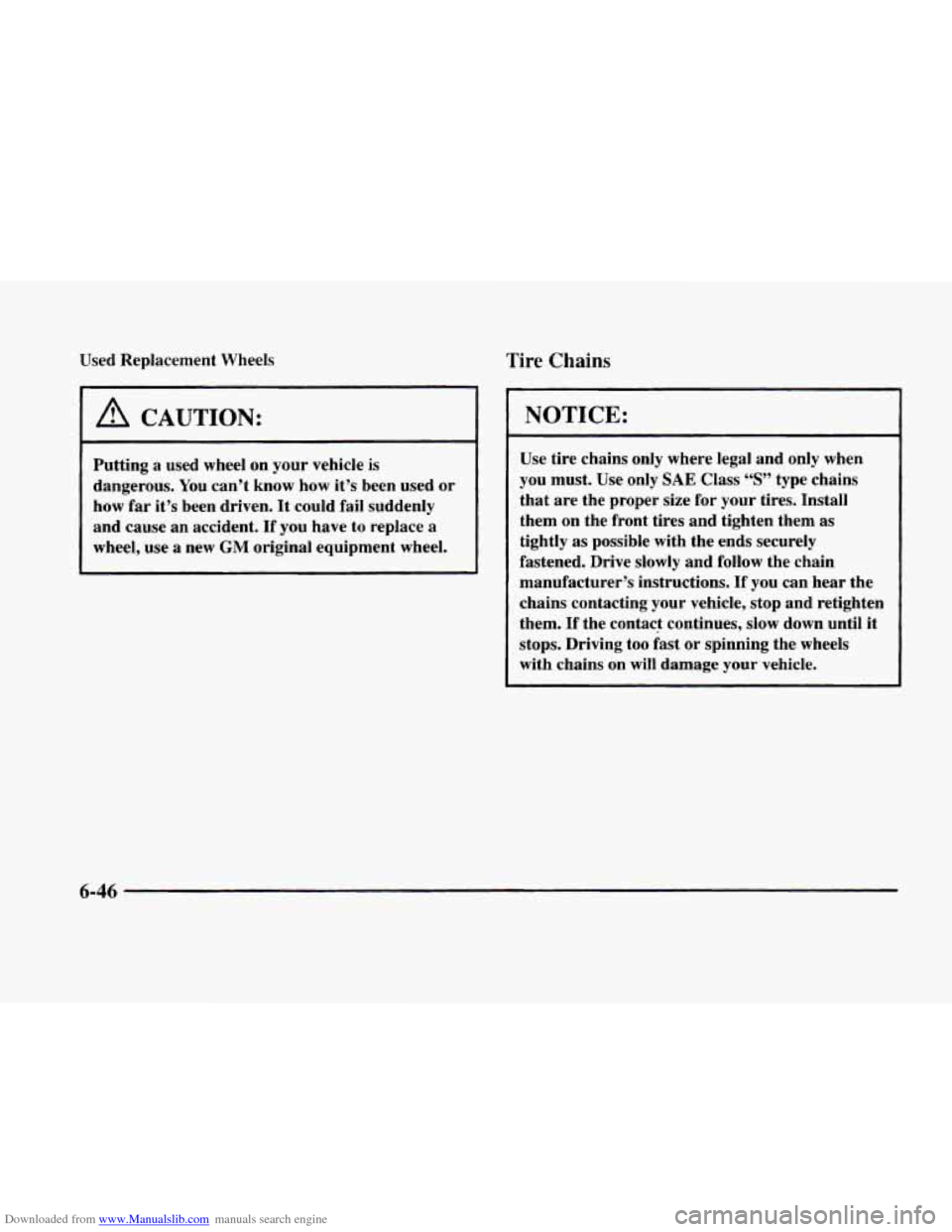1998 CADILLAC ELDORADO wheel
[x] Cancel search: wheelPage 324 of 380

Downloaded from www.Manualslib.com manuals search engine Treadwear
The treadwear grade is a comparative rating based on
the wear rate of the tire when tested under controlled
conditions
on a specified government test course.
For example, a tire graded
150 would wear one and a
half (1 1/2) times as well on the government course
as a tire graded 100. The relative performance
of tires
depends upon the actual conditions
of their use,
however, and may depart significantly from the norm
due to variations
in driving habits, service practices
and differences in road characteristics and climate.
Traction -- A, B, C
The traction grades, from highest to lowest, are A, B,
and C, and they represent the tire’s ability to stop
on wet pavement as measured under controlled
conditions
on specified government test surfaces
of asphalt and concrete.
A tire marked C may have
poor traction performance.
Warning: The traction grade assigned to this tire is based
on braking (straight ahead) traction tests and does not
include cornering (turning) traction.
Temperature -- A, B, C
The temperature grades are A (the highest), B, and C,
representing the tire’s resistance to the generation of heat and
its ability to dissipate heat when tested under
controlled conditions on a specified indoor laboratory
test wheel. Sustained high temperature can cause the
material
of the tire to degenerate and reduce tire life, and
excessive temperature can lead
to sudden tire failure.
The grade
C corresponds to a level of performance
which all passenger car tires must meet under the
Federal Motor Vehicle Safety Standard No.
109. Grades
B and A represent higher levels of performance on the
laboratory test wheel than the minimum required by law.
Warning:
The temperature grade for this tire is
established for a tire that is properly inflated and not
overloaded. Excessive speed, underinflation, or
excessive loading, either separately
or in combination,
can cause heat buildup and possible tire failure.
Wheel Alignment and Tire Balance
The wheels on your vehicle were aligned and balanced
carefully at
the factory to give you the longest tire life
and best overall performance.
Scheduled wheel alignment and wheel balancing are not
needed. However, if you notice unusual tire wear or
your vehicle pulling one way or
the other, the alignment
may need to be reset. If
you notice your vehicle
vibrating when driving
on a smooth road, your wheels
may need to be rebalanced.
6-44
Page 325 of 380

Downloaded from www.Manualslib.com manuals search engine Wheel Replacement
~eplace any wheel that is bent. cracked, or badly ruslea
or corroded.
If wheel nuts keep coming loose, the wheel,
wheel bolts
and wheel nuts should be replaced. If the
wheel leaks air, replace
it (except some aluminum
wheels, which can sometimes be repaired). See your
dealer
if any of these conditions exist.
Your dealer will know the kind
of wheel you need.
Each new wheel should have the same load-carrying
capacity. diameter, width, offset and be mounted the
same way as
the one it replaces.
If
you need to replace any of your wheels, wheel bolts
or wheel nuts. replace them
only with new GM original
equipment parts. This way, you will be sure to have the
right wheel, wheel bolts and wheel
nuts for your
Cadillac model.
A CAUTION:
Using the wrong replacement wheels, wheel
bolts or wheel nuts
on your vehicle can be
dangerous. It could affect the braking and
handling
of your vehicle, make your tires lose
air and make you lose control. You could have a
collision in which you or others could be injured.
Always use the correct wheel, wheel bolts and
wheel nuts for replacement.
NOTICE:
The wrong wheel can also cause problems with
bearing life, brake cooling, speedometer
or
odometer calibration, headlamp aim, bumper
height, vehicle ground clearance and tire or tire
chain clearance to the body and chassis.
See “Changing a Flat Tire” in the Index for more
information.
6-45
Page 326 of 380

Downloaded from www.Manualslib.com manuals search engine Used Replacement Wheels Tire Chains
A CAUTION:
~ ~ ~~ ~~
Putting a used wheel on your vehicle is
dangerous. You can’t know how it’s been used or
how far it’s been driven.
It could fail suddenly
and cause an accident.
If you have to replace a
wheel, use a new GM original equipment wheel.
NOTICE:
Use tire chains only where legal and only when
you
must. Use only SAE Class “S” type chains
that are the proper size for your tires. Install
them on the front tires and tighten them as tightly
as possible with the ends securely
fastened. Drive slowly and follow the chain
manufacturer’s instructions.
If you can hear the
chains contacting your vehicle, stop and retighten
them. If the contact continues, slow down until it
stops. Driving too fast
or spinning the wheels
with chains on will damage your vehicle.
6-46
Page 332 of 380

Downloaded from www.Manualslib.com manuals search engine Cleaning Aluminum or Chrome
Wheels
(If Equipped)
Keep your wheels clean using a soft clean cloth with
mild soap and water. Rinse with clean water. After
rinsing thoroughly, dry with a
soft clean towel. A
wax may then be applied.
The surface of these wheels
is similar to the painted
surface
of your vehicle. Don’t use strong soaps,
chemicals, abrasive polishes, abrasive cleaners or
abrasive cleaning brushes on them because you could
damage the surface. You may use chrome polish on
chrome wheels, but avoid any painted surface of the
wheel, and buff off immediately after application.
Don’t take your vehicle through an automatic car wash
that has silicon carbide tire cleaning brushes. These
brushes can also damage the surface of these wheels.
Cleaning Tires
To clean your tires, use a stiff brush with a tire cleaner.
I NOTICE: I
When applying a tire dressing always take care
to wipe
off any overspray or splash from all
painted surfaces on the body or wheels
of the
vehicle. Petroleum-based products may damage
the paint finish.
Sheet Metal Damage
If your vehicle is damaged and requires sheet metal
repair or replacement, make sure the body repair shop
applies anti-corrosion material
to the parts repaired or
replaced to restore cofrosion protection.
Finish Damage
Any stone chips, fractures or deep scratches in the finish
should be repaired right away. Bare metal will corrode
quickly and may develop into a major repair expense.
Minor chips and scratches can be repaired with touch-up
materials available from your dealer
or other service
outlets. Larger areas
of finish damage can be corrected
in your dealer’s body and paint shop.
Page 343 of 380

Downloaded from www.Manualslib.com manuals search engine Fuse
CLUSTER ACC
Usage
Steering Wheel Controls, Cluster
PZM, Electrochromic Mirror,
Rain Sensor (Optional
j.
Accessory Relay
HTD BACKLT Rear Window Defog
HTD MIR
HTD SEAT
R
HTD SEAT'L
PULL DOWN
ANTENNA
RSS
CONVENC Right
and Left Outside
Heated Mirror
Passenger Heated Seat
Relay (Optional)
Driver Heated Seat Relay
(Optional)
Trunk Pull-Down Motor
Power Mast Antenna
Road Sensing Suspension Module
(ETC Only)
Trunk Release Relay. Trunk
Release Solenoid,
Fuel Door
Release Relay. Fuel Filler Door
Release Solenoid, Door Lock
Relay, Left Front Door Motors,
PZM, Door Unlock Relay
Fuse
BATT
RSS
RT PARK
LT PARK
Usage
Driver and Passenger Seat Lumbar
Switch (Optional
jl. Driver and
Passenger Seat Belt Comfort
Solenoid, Memory Seat Module
CV-RTD (CV-RSS) (ETC Only)
Headlamp Switch, Right Front
Parking Lamp, Right Front and
Rear Sidemarker Lamps, Right
Park Position Lamp
(Export),
Right Turn/Stop/TTail Lamps, Rear
Fog Lamp Relay (Export), Right
and Left Rear Fog Lamps (Export)
Left Front and Rear Sidemarker
Lamps, Left Front Parking Lamp,
Left Park Position Lamp (Export),
Left Turn/Stopi'"ail Lamps, Right
and Left License Lamps,
Underhood
Lamp
* Do not alter OBD I1 related fuses or circuit breakers.
6-63
Page 344 of 380

Downloaded from www.Manualslib.com manuals search engine Replacement Bulbs
Application Number
Headlamps Composite Inner High Beam
....................... 9005
Outer Low Beam ....................... 9006
Front Turn Signal ..................... 2357 NA
Center High-Mounted Stoplamp (CHMSL) ... 1156
Rear Turn Signal and Taillamp ............. 2057
Capacities and Specifications
Displacement ......... 279 cubic inches (4 565 cc)
Engine Specifications
Type .......................... 4.6L DOHC V8
Eldorado ............................... Y
ETC .................................. 9
VIN Engine Code
Horsepower Eldorado
.............. 275 (bhp) @ 5600 rpm
ETC ................. 300 (bhp) @ 6000 rpm
205 (kWj @ 5600 rprn
224 (kWj @ 6000 rpm Torque
Eldorado
............. 300 (lb-ft) @ 4000 rpm
ETC ................ 295 (lb-ft) @ 4400 rpm
Firing Order
................... 1-2-7-3-4-5-6-8
407
(N-m)
@ 4000 rpm
400 (N-m) @ 4400 rpm
Thermostat Starts
To Open . . 177-184°F (81-85°C)
Capacities
Crankcase (Engine Oil
Transaxle (4T80-E) .......... 15 quarts (14.2 Lj
with Filter Change) ........... 7.5 quarts (7.1 L)
Engine Cooling System
........ 12.5 quarts ( 1 1.8 L)
R- 134a Refrigerant .............. 2 lbs. (0.91 kg)
Wheel Base
............... 108 inches (274.3 cm)
Length
................. 200.2 inches (508.6 cm)
Height
................... 53.6 inches ( 136.2 cm)
Fuel Tank
....... : ........... 20 gallons
(75.7 L)
Vehicle Dimensions
Width ................... 75.5 inches (191.8 cmj
Front Tread
............... 60.9 inches (154.7 cm)
6-64
Page 345 of 380

Downloaded from www.Manualslib.com manuals search engine Rear Tread ........................ 60.9 inches
(154.7 cm)
Wheel Nut Torque ................... 100 lb-ft
(140 N-m)
Air Conditioning Refrigerants
Not all air conditioning refrigerants are the same.
If the air conditioning system in your vehicle needs
refrigerant, be sure the proper refrigerant is used.
If
you’re not sure, ask your dealer.
Normal Maintenance
Replacement Parts
Air Filter Element ............. AC Type A 1096C
Fuel Filter Element
............ AC Type GF-580
Engine Oil Filter ................ AC Type PF-58
PCV Valve .................. AC Type CV-774C
Spark Plugs
................... AC Type 41 -900
Thermostat .................... AC Type 13 1-66
Windshield Wiper Blade (Pin Type)
................ .22 inches (56.5 ern)
6-65
Page 363 of 380

Downloaded from www.Manualslib.com manuals search engine ........
Section 8 Index
ABS ......................................... 4-7
Adding Equipment to the Outside
of Your Vehicle ...... 6-3
AirBag
....................................... 1-20
How Does it Restrain
.......................... 1-24
How it Works
................................ 1-22
Location
.................................... 1-22
Readiness Light
......................... 1-21. 2-61
Servicing
................................... 1-25
What Makes it Inflate
.......................... 1-23
What Will You See After it Inflates
............... 1-24
When Should
it Inflate ......................... 1-23
Aircleaner
.................................... 6-15
Air Conditioning ................................ 3-6
Air Conditioning Refrigerants
..................... 6-65
Air Control. Climate Control System
............. 3-3. 3-4
Alarm. Theft-Deterrent
.......................... 2- 14
Alignment and Balance. Tire
...................... 6-44
Aluminum Wheels. Cleaning
...................... 6-52
Antenna. Power
................................ 3-37
Antifreeze
................................ 6-22. 6-23
Anti-Lock
Brake System Warning Light
................ 2-64. 4-7
Brakes
...................................... 4-7
Anti-Lockout Feature
............................ 2-5
Anti-Theft. Radio
.............................. 3-33
Appearancecare
............................... 6-47
Appearance Care Materials
....................... 6-54
Apply Brake To Shift Message .................... 2-71
Arbitration Program
............................. 7-11
Armrest. Storage
.......................... 2.49. 2.X
Ashtrays
...................................... 2-3
Assist Handles
................................. 2-51
Astroroof
..................................... 2-52
Audio Equipment. Adding ........................ 3-3~
Audio Steering Wheel Controls
.................... 3-3:
Audio Systems
.................................. 3-5
Automatic Transaxle
Fluid ....................................... 6-1t
Operation
................................... 2-21
Overdrive
................................... 2-22
Shifting
..................................... 2-21
Starting Your Engine
.......................... 2-15
Automatic Door Locks
............................ 2-2
Automatic Pull-Down Feature
..................... 2-12
Battery
...................................... 6-31
Charging System Indicator Light
................. 2-62
Jump Starting ................................. 5-?
No Charge Message ........................... 2-72
Replacement, Remote Keyless Entry
............... 2-1
Volts High Message ........................... 2-72
Volts Low Message
........................... 2-72
Warnings
................................ 5-3, 5-5